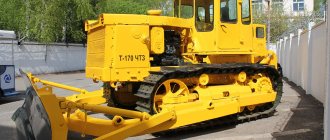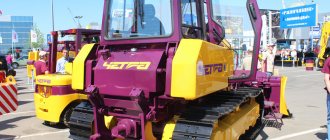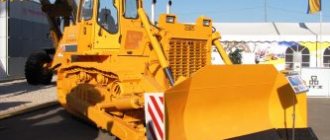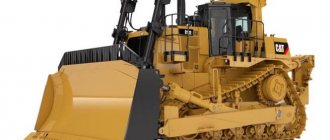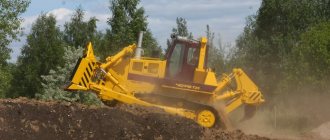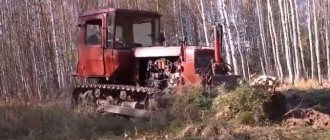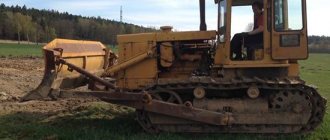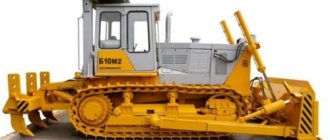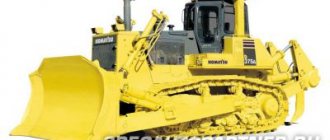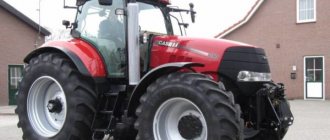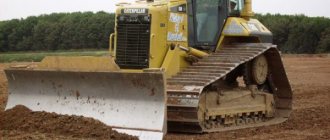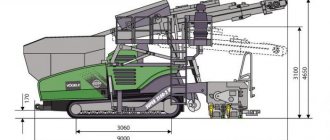When developing pits, excavations and embankments, it is advisable to use a bulldozer set of equipment if the average range of longitudinal or transverse transportation does not exceed 100 meters. To choose the most optimal model of special equipment, it is necessary to compare the performance of bulldozers with different traction classes and different types of working equipment.
The most promising are tracked vehicles. Equipment with pneumatic wheels is in less demand. When calculating the productivity of an earthmoving machine, it is necessary to take into account terrain conditions, the nature of the work and other factors.
Basic information about bulldozers
A bulldozer is an earth-moving and transport machine for layer-by-layer development and transportation of soil, developed on the basis of a tracked or pneumatic-wheeled tractor with replaceable attachments - a blade (a flat shield with side flaps), a frame and a control mechanism.
Equipment with a fixed and rotating blade is used. In the first case, the working equipment is located perpendicular to the longitudinal axis, which allows moving soil masses only in front of the machine. The productivity of bulldozers with a rotary blade is much higher, since such specimens are capable of moving soil to the side at an angle of 60 degrees, which allows for rough leveling work.
The blade control mechanism can be cable-block or hydraulic. The second type of control is more productive, as it allows you to force the blade into the ground.
We are modernizing the working body
Soil losses can also be reduced by increasing the volume of dumps. Professionals attach additional windshields, extensions and flaps to them. Frontal shields are welded to the top of the dump to increase its height, which prevents soil from spilling through the dump. Installing shields with a height of 300-350 mm on the dump allows you to increase the volume of the dump by 10-15%.
Extensions and flaps are attached to the side walls of the blade, installing them parallel or at some angle to the longitudinal axis of the tractor. The use of expanders and openers allows you to increase the volume of transported soil by almost 1.8 times.
In addition, protruding middle knives are attached to the dumps. True, on loose and waterlogged soils this does not provide any advantages over the usual one, so this option is advisable to use when developing cohesive soils of categories II-V of complexity, frozen soils, some rocks such as chalk and limestone, as well as in stripping quarries. In addition, good results are obtained when destroying old asphalt concrete pavements and especially when constructing trays, trenches for drainage pipes, drainage and upland ditches, for constructing troughs when expanding the carriageway of highways at the expense of roadsides and under temporary rutted tracks of logging roads. The use of bulldozers with a protruding knife can be recommended for civil, industrial, road, irrigation and drainage construction, in the mining industry and other sectors of the national economy.
Traction class of vehicles
Bulldozers are used to carry out up to 40% of all excavation work on a construction site. They are most effective with an average longitudinal and transverse hauling distance of 100 to 150 meters. When the machines are equipped with special shovel-type dumps, the effective range of transporting sandy soils increases to 200 meters.
The main parameter influencing performance is the traction class - the force with which a bulldozer can push the soil forward. The technical characteristics of the machines affect the volume of earth moved and the speed of work. According to this parameter, all bulldozers are divided into three groups:
- Lightweight, the tractive force of which does not exceed 60 kN. They are used during preparatory, agricultural and auxiliary work.
- Medium, with a traction force of 100-150 kN. Used to develop 1-3 groups of soil with preliminary loosening.
- Heavy, the tractive force of which exceeds 250 kN. They are used in the development of dense and hard rocks.
Bulldozers are used in combination with other earthmoving machines. They can be used as pushers for self-propelled and trailed scrapers. Typically, a bulldozer equipment set includes a tamping machine and a ripper.
When the team works
In the case of grading large areas, as well as when moving heavy clay or rock, it is advisable to use several bulldozers at the same time. They move side by side at a distance of up to 0.5 m from each other. By reducing losses, the volume of soil moved by each bulldozer increases by 10-15%. The experience of bulldozer operators is important here - after all, they need to move at the same speed. Reducing the speed or stopping one of the bulldozers disrupts the rhythm of work of all machines.
Factors Affecting Performance
When calculating the performance of bulldozers, it is necessary to take into account the physical and mechanical characteristics of the developed earth mass, as well as local conditions. The main physical and mechanical characteristics of the soil include:
- granulometric composition - the ratio of the sizes of soil particles by mass;
- density - the mass of soil per unit volume;
- porosity - the number of voids between grains, expressed as a percentage by weight;
- plasticity number - the humidity range in which the soil has plastic properties and does not go into a fluid state;
- swelling - the ability of an earth mass to increase in volume when waterlogged;
- angle of internal friction - the shear resistance of soil particles.
Local conditions affecting the performance of bulldozers include the nature of the relief and technological features of the construction site. On a flat and straight section with a minimum range of transverse carriage, the speed of work is much higher than on hilly terrain.
Calculation of bulldozer performance
The performance of a bulldozer depends on the type of work performed. This can be excavation and transport or planning work. In the first case, productivity is expressed in m3/h, in the second - m2/h. Let's take a closer look at earthmoving and transport work.
Operational productivity is determined by the volume of earth mass that special equipment is capable of developing and moving per unit of time, that is, in one hour. Bulldozer productivity is calculated using the formula
To calculate productivity as close as possible to the real one, correction factors are introduced:
- ky is the influence of the slope of the earthen site. When working on slopes of 5-15%, the value increases from 1.35 to 2.25; when developing soil on an uphill slope, the coefficient decreases from 0.67 to 0.4;
- kв – value taking into account the time of use of the machine (kв = 0.8-0.9);
- kн – filling coefficient of the geometric volume of the drawing prism (kн = 0.85-1.05).
To calculate productivity, it is also necessary to know the volume of the drawing prism (Vgr) and the duration of the machine operating cycle (Tc).
Formula for calculating when processing one volume of soil per unit of time (m3/hour)
Bulldozer performance when excavating soil
Calculation when developing soil
When working to develop soil and transport it over a distance, the bulldozer performs a repeating cycle of actions . In this case, the performance of the machine is expressed by the formula :
П=(q*n*Kn*Ki*Kb)/Kp,
in which the components are:
- P – productivity, m3/hour;
- q – the volume of soil that is moved by a shovel and is determined by the numerical dimensions of the dump and factors influencing the movement;
- n is the number of repeating circles per unit of time in relation to the transportation distance;
- Кn – coefficient taking into account volume losses in the side rollers, depends on the distance of movement and type of soil;
- Ki is a coefficient characterizing the slope of the machine’s path;
- Kv – coefficient showing the degree of initial loosening of the soil;
- Kr is a coefficient that determines the rational use of labor time.
- Number of tractor operation cycles per unit of time (hour):
- n= 3600/tc
Cycle duration:
- tc=tn+tg.x.+txx+2*tp+m*tp.p.+to=ln/kv*vn+lg.x./ kv*vg.x.+(ln+lg.x.) /(kv*vх.х.)+2*tп+m*tп.п.+t0
- where t – duration:
- tн – soil collection, s;
- tg.x. – loaded passage, s;
- tx.x. – idle speed, s;
- tп. – one rotary action (10-20 seconds);
- tp.p. – one speed shift (5-6 seconds);
- t0 – lowering the shovel to the initial position (2 seconds).
- m is the number of changes in bulldozer speeds during one stroke;
- lн – soil removal path, m;
- lg.x. – length of the movement distance to the place of accumulation, m;
- vн, vг.х, vx.x – speed of movement of the tractor during cutting, ground movement and return stroke, m/s;
- kv is a coefficient that takes into account the level of reduction in tractor speed compared to the calculated one: 0.7-0.75 when moving a load, 0.85-0.90 when idling in return;
Soil volume
The coefficient of lost soil volumes in boulders depends only on the distance of soil movement and is expressed by the following relationship:
Kn=1-Ki*lг.х.
Where:
- K1 is a coefficient obtained by a laboratory method, the value of which varies within 0.008...0.04, depending on the dry or cohesive state of the soil;
- Lg.x. – length over which the soil moves, m.
If it is necessary to move soil over a distance of more than 30 m, the use of bulldozers is considered irrational due to large losses of soil during movement. In this case, cargo can be transported by dump trucks, for example, on any of the Kamaz model range.
The volume of soil that a bulldozer can move a certain distance depends on the slope of the work site. So, on descents from a hill, the volume of moved soil will be significantly greater, which means the machine’s productivity will increase.
It is difficult to live in a private house in winter without a snow blower. If you are thinking about purchasing this equipment, then read our article.
You can choose either an electric snow blower or a gasoline one. To be clear, check out this article on gas snow blowers.
If you have a chainsaw and don’t want to spend money on a snow blower, you can make one yourself. Find out exactly how in this article.
Cycle duration
To calculate the duration of the working cycle, that is, the time that a bulldozer tractor will spend on developing one layer of soil, it is necessary to understand that the entire length of the longitudinal or transverse carriage is divided into several segments. The duration itself is calculated using the formula
Here lp, ln and lo = lp+ln are the lengths of the cutting sections, movement of the soil mass and the reverse movement of special equipment, and vp, vn and vo are the maximum possible speeds in these sections. The coefficient tn takes into account the time that the driver spends changing gears while working. Usually it is 15-20 seconds.
Bulldozer performance with a wedge operating pattern
The use of a wedge soil collection scheme is possible only with those machines that are equipped with a hydraulic blade control mechanism. Such, for example, is the Shantui SD32 bulldozer. A distinctive feature of this principle of soil development is the fact that the cutting force gradually decreases as the drawing prism increases.
At the beginning of work, all the forces of the machine are aimed at plunging the blade into the ground to the maximum depth hmax and cutting the earth mass. As the bulldozer moves, soil accumulates in front of the bulldozer, causing movement resistance to increase. For further work, the operator must increase the applied traction force or reduce the cutting depth.
Digging
The bulldozer experiences the greatest resistance during the process of digging the soil. When moving it, the machine uses all power reserves. The process involves removing a large amount of cut earth from the spoil using the full engine power. 3 soil digging schemes have been developed:
- rectangular chips of equal thickness;
- a special wedge version, where the thickness of the chips varies;
- comb notch.
When cutting using the first method, the blade of the unit, in accordance with the technical feasibility and type of soil, is immediately buried deep enough. While in this position, the machine moves forward, cutting even chips as it moves.
Scheme of cutting and moving soil
This cutting method is used for work on a slope or excavation with inclined balls. The power of the bulldozer is fully utilized, which allows for uniform cutting of the layer. With this method, a reduction in distance and time is achieved. This technology is appropriate when a scheme for cutting plant soil is used.
The wedge excavation pattern is appropriate when working with light or slightly moist soils. At the very beginning, the bulldozer blade is inserted into the ground as deep as possible. As the machine moves forward, the blade gradually rises, containing the removed soil.
This digging technique allows for a shorter cutting path and also reduces set-up time. The blade cutting scheme is impractical on heavy, very dense soils. This is due to possible difficulties in deepening the dump.
For these types of soil, ridge excavation technology is suitable. The dump is buried deep enough into the soil. When the diesel engine speed decreases, the blade is raised to about a third of its depth. Such manipulations (depths with lifts) are done at intervals of 2–3 times per pass. During the event, the soil is completely excavated for the dump of the machine.
Scheme of the trench method of soil development
By using this scheme, you can achieve almost complete use of the bulldozer’s power. The advantages of this method also include a reduction in the time of soil accumulation, although the driver quickly gets tired, since he often has to operate the control levers. The scheme is suitable for soils with optimal moisture.
To increase the efficiency of cutting soil with a bulldozer, models of dumps are used that have a medium, strongly protruding blade. This helps increase production efficiency by almost 40%.
Here you can download a manual for excavation work with bulldozers.
Thickness of earth shavings
Most often they resort to the second option, but in this case part of the earth is “lost” in the side rollers (which is also bad for the Shantui bulldozer). To compensate for these losses, the machine must cut off “chips” along the entire path of movement, which is calculated by the formula
Here kп is a correction that takes into account soil loss during transportation, kpr is the drawing prism coefficient, which is taken from the operational characteristics of the machine, Lп is the length of the section where soil cutting occurs. It is defined as the ratio of the volume of the drawing prism to the area of the developed area.
Impact of Blade Type on Productivity
Depending on the characteristics of the soil, as well as on the tasks assigned to the bulldozer, it is advisable to use certain types of dumps. This will reduce the period of work and also increase the efficiency of special equipment.
Any machine, including the Japanese-made Komatsu bulldozer, is equipped with a replaceable blade. Among the main types of working equipment it is worth highlighting:
- reclamation subspecies, which is used to remove the top fertile layer of the earth, chernozem;
- a type for moving coal and wood chips - used in mining, has a hemispherical shape and a hydroperiscope;
- the “peat” variety has a reduced height but increased length and is used to enrich agricultural fields;
- dumps for site preparation - brush cutters and uprooters, which are equipped with teeth, are produced in a V-shape and are designed for clearing the area of trees and bushes.
The most progressive (in terms of the ability to install various working equipment) is the Japanese Komatsu bulldozer. All models of special equipment can be equipped with any of the presented dumps, which gives them high functionality and makes them universal machines for construction sites.
Calculation of bulldozer productivity must be carried out to reduce the cost of excavation work. Based on the data obtained, you can select the most optimal special equipment for the job, reduce the time required to complete the work, and save a lot of money.
